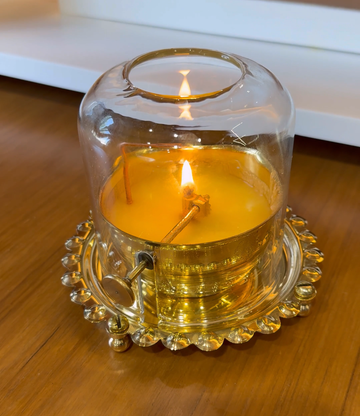The sacred Hindu festival of Maha Shivratri will be celebrated on February 26, 2025. This holy night is dedicated to Lord Shiva, symbolizing his divine energy, cosmic power, and ultimate reality. Devotees observe fasts, offer prayers, and perform special rituals to seek the blessings of Mahadev. Among these rituals, lighting an Akhand Jyot Diya (eternal flame) holds immense spiritual importance.
In this blog, we will explore the significance of the Akhand Jyot and provide a step-by-step guide on how to maintain it throughout the night during Maha Shivratri.
Significance of the Akhand Jyot on Maha Shivratri
Lighting an Akhand Jyot on Maha Shivratri is believed to bring divine energy and blessings into the home. It symbolizes:
-
Divine Presence – The flame represents Lord Shiva’s eternal strength, guidance, and illumination.
-
Triumph of Light Over Darkness – It dispels negativity and ushers in spiritual enlightenment.
-
Unwavering Devotion – A continuously burning flame reflects the devotee’s deep faith and commitment to Lord Shiva.
-
Blessings for Peace and Prosperity – Worshipping in front of the Akhand Jyot is believed to bring good fortune and the fulfillment of prayers.
How to Light and Maintain an Akhand Jyot on Maha Shivratri
If you plan to keep an Akhand Jyot at home or in a temple, follow these essential steps to ensure it burns throughout the night:
1. Choosing the Right Diya (Lamp)
-
Opt for a brass, clay, or silver diya, as these materials hold religious significance.
-
Ghee diyas are considered ideal due to their pure and long-lasting flame.
-
Alternatively, mustard oil can be used for its traditional and spiritual value.
2. Selecting the Right Wick (Baati)
-
Use cotton wicks for a steady and pure flame.
-
Twisting multiple wicks together can help the diya burn longer.
3. Sacred Placement of the Akhand Jyot
-
Place the diya in front of a Shivling, Lord Shiva’s idol, or in your puja room.
-
Position it in the northeast direction, which is considered the most auspicious.
-
Ensure it is kept away from direct wind to prevent the flame from extinguishing.
4. Maintaining the Flame Throughout the Night
-
Keep extra ghee or oil nearby to refill the diya as needed.
-
Avoid placing the diya in areas with high movement or disturbance.
-
Ensure someone remains awake to monitor the flame and maintain its steady glow.
5. Chanting Mantras and Offering Prayers
To enhance the spiritual benefits of the Akhand Jyot, chant these powerful mantras:
-
Maha Mrityunjaya Mantra – For good health and longevity. “Om Tryambakam Yajamahe Sugandhim Pushtivardhanam
Urvarukamiva Bandhanan Mrityor Mukshiya Maamritat” -
Rudra Ashtakam – To invoke Lord Shiva’s divine blessings.
-
Shiva Tandav Stotra – For spiritual awakening and transformation.
-
Om Namah Shivaya – A simple yet powerful mantra to connect with Lord Shiva.
6. Concluding the Ritual
-
After Maha Shivratri night, offer flowers and seek blessings from Lord Shiva.
-
Do not blow out the Jyot; let it burn out naturally or extinguish it gently using a flower.
Final Thoughts
Observing Maha Shivratri with an Akhand Jyot fills your home with divine energy, positivity, and spiritual grace. It is a way to connect with Lord Shiva, invite his blessings, and undergo inner transformation.
This Maha Shivratri, may your prayers be answered, and your life be filled with peace, prosperity, and spiritual enlightenment. Har Har Mahadev!




